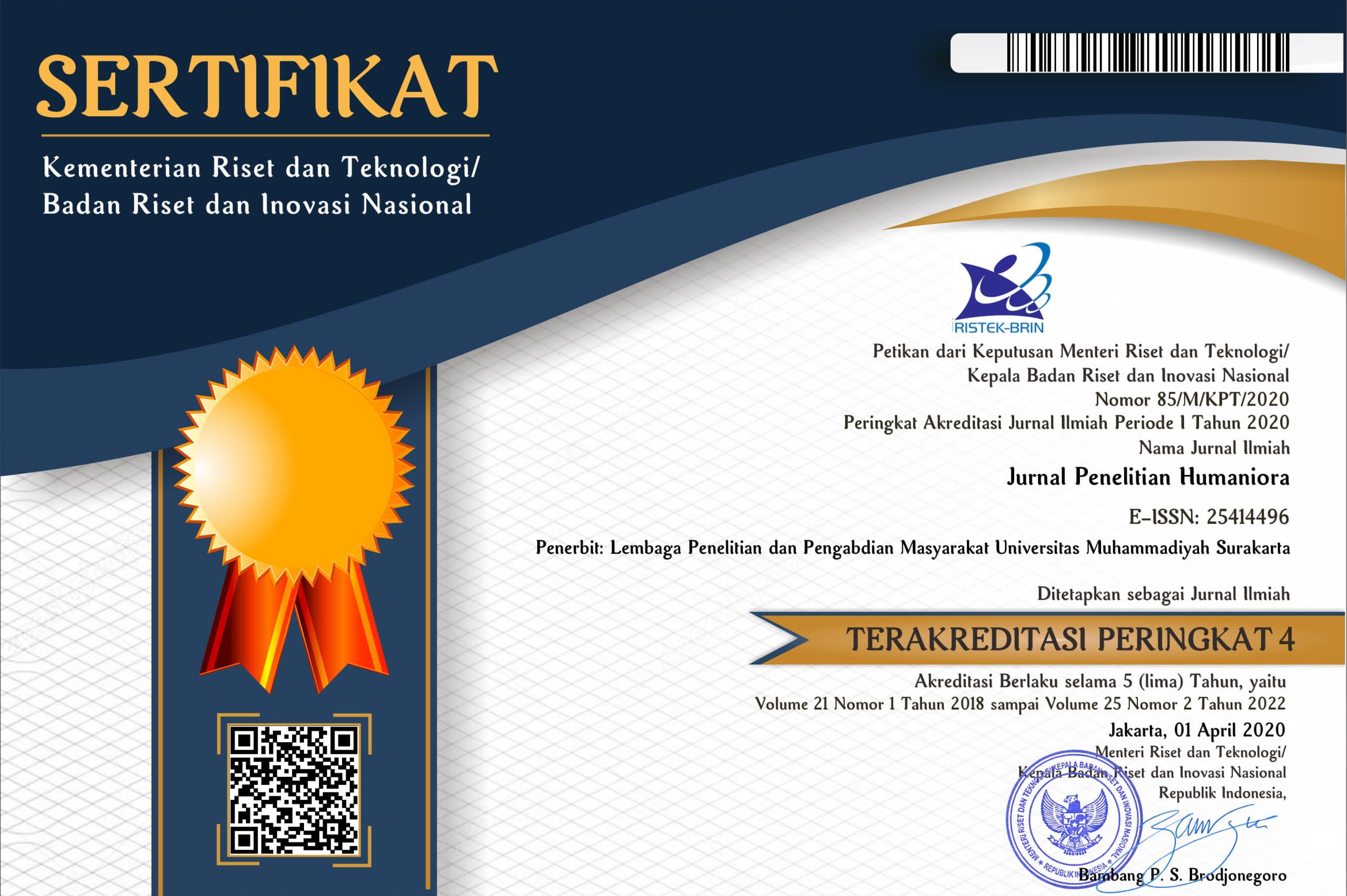The Use of Constructions in The Novel The Autumn of The Patriarch by Gabriel Garcia Marquez
Sri Haryanti(1*), Purwo Haryono(2), Ana Setyandari(3), Sukasih Ratna Widayanti(4)(1) Universitas Widya Dharma Klaten
(2) Universitas Widya Dharma Klaten
(3) Universitas Widya Dharma Klaten
(4) Universitas Widya Dharma Klaten
(*) Corresponding Author
Abstract
Keywords
Full Text:
PDFReferences
Al-Mekhlafi, A. M., & Nagaratnam, R. P. (2011). Difficulties in teaching and learning grammar in an EFL context. International Journal of Instruction, 4(2), 69–92.
Aqel, I. M. (2013). The effect of using grammar-translation method on acquiring English as a foreign language. International Journal of Asian Social Science, 3(12), 2469–2476.
Ary, D., Jacobs, L. C., Sorensen, C., & Razavieh, A. (2010). Introduction to research in education (8th ed.). United States of America: Wadsworth, Cengage Learning.
Bailey, S. (2006). Academic writing, a handbook for international students (2nd Ed.). Great Britain: MPG Books Ltd, Bodmin.
Baker, C. L. (1995). English syntax (2nd Ed.). Cambridge: The MIT Press.
Crystal, D. (2008). A dictionary of linguistics and phonetics. United States of America: Blackwell.
DeCapua, A. (2017). Grammar for teachers, a guide to American English for native and non-native speakers (2nd Ed.). Switzerland: Springer International Publishing.
Frank, M. (1972). Modern English, a reference guide. New Jersey: Prentice Hall, Inc.
Hornby, A. S. (2000). Oxford advanced learner’s dictionary (6th ed.). Oxford: Oxford University Press.
Leech, G. (1983). Principles of pragmatics. London: Longman Group Limited.
Lock, G. (1996). Functional English grammar, an introduction for second language teachers. Cambridge: Cambridge University Press.
Ritchie, J., & Lewis, J. (2003). Qualitative research practice: a guide for social science students and researchers. London: SAGES Publications Ltd.
Sudaryanto. (2001). Metode dan aneka teknik analisis bahasa: pengantar penelitian wahana kebudayaan secara linguistis. Yogyakarta: Duta Wacana University Press.
Sutopo. (2006). Metode penelitian kualitatif. Surakarta: Sebelas Maret University Press.
Uibu, K., & Liiver, M. (2015). Students’ grammar mistakes and effective teaching strategies. International Journal of Teaching and Education, III(1), 70–87.
Uysal, H. H., & Bardakci, M. (2014). Teacher beliefs and practices of grammar teaching: focusing on meaning, form, or forms? South African Journal of Education, 34(1), 1–16.
Wahyuni, N. T., Fauziati, E., & Hikmah, M. (2016). The effectiveness of using phonics instruction and storybooks in English reading classes to improve student participation. Jurnal Penelitian Humaniora, 17(1), 49-64.
Webster, M. (2019). Definition of character.
Yamin, M., Saputra, A., & Deswila, N. (2021). Enhancing Critical Thinking in Analyzing Short Story “The Lazy Jack” Viewed from Identity Theory. In-donesian Journal on Learning and Advanced Education (IJOLAE), 3(1), 30-39.
Article Metrics
Abstract view(s): 441 time(s)PDF: 420 time(s)
Refbacks
- There are currently no refbacks.











